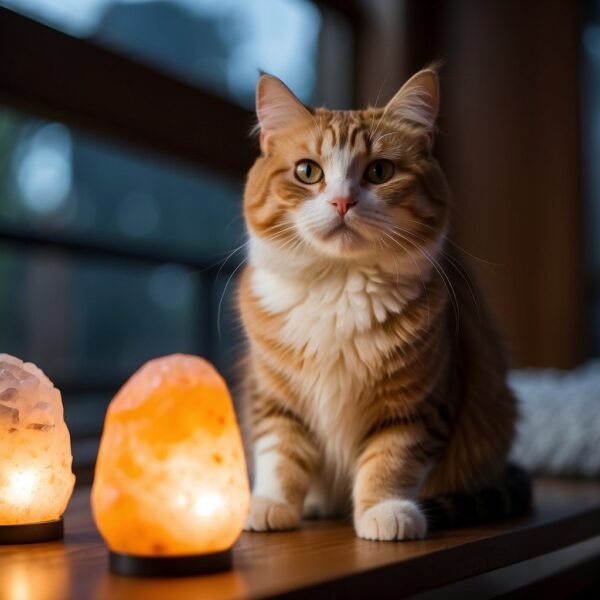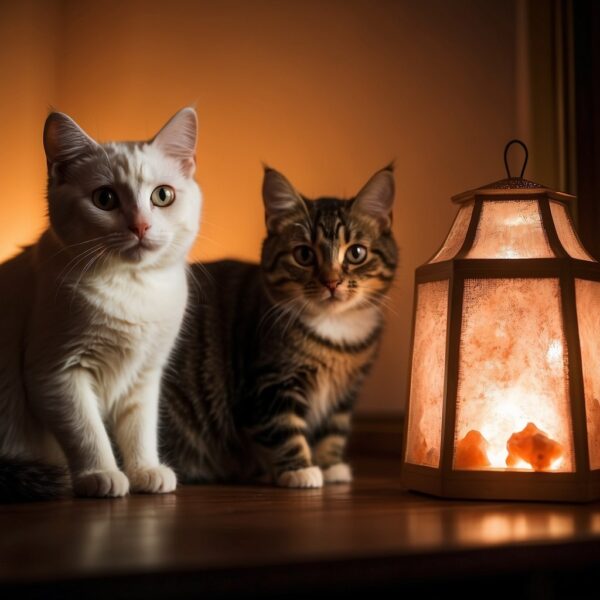
Cats and Himalayan Salt Lamps: Understanding the Risks
Himalayan salt lamps, with their warm glow and aesthetic appeal, have become a popular item in many households. These lamps are made from pink salt crystals mined from the Himalayan mountains and are often sought after for their reported health and environmental benefits. However, cats and Himalayan salt lamps in the same households warrants closer consideration. Cats, being naturally curious animals, may be attracted to the texture and taste of these lamps, leading to potential risks for their health.
While the lamps are touted for their ability to improve air quality and mood in humans, the same purported benefits have not been conclusively demonstrated for cats. Moreover, high amounts of salt can be harmful to cats if ingested. It is essential for cat parents to be aware of these risks and to take precautions when incorporating Himalayan salt lamps into their home décor. Ensuring that the lamps are out of reach from their feline companions can prevent accidental ingestion and maintain a safe environment for all occupants.
Key Takeaways
- Himalayan salt lamps may pose a health risk if cats ingest large amounts of salt.
- The benefits of salt lamps for air quality and mood enhancement are not proven for cats.
- Ensuring salt lamps are inaccessible to cats is important for their safety.
Cats’ Interaction with Himalayan Salt Lamps
Cats may be drawn to Himalayan salt lamps because of their warm glow and texture. It’s crucial for cat parents to understand this interaction to ensure the safety of their feline friends.
Attraction Factors for Cats
Cats are naturally curious creatures attracted to the pink color and soft glow of Himalayan salt lamps. The tactile sensation of licking a salt lamp may also appeal to some cats, which can be dangerous due to the potential of salt poisoning. These lamps can also boost the ambiance of a home, possibly affecting a cat’s energy levels and behavior.
Understanding Cat Behavior Around Salt Lamps
Cats often explore their environment using their senses, and a Himalayan salt lamp can be particularly enticing. A cat’s licking behavior can lead to excess sodium intake, which jeopardizes their electrolyte balance and may result in serious health risks. Continued contact with the lamp can pose hazards such as salt toxicity.
How to Monitor Your Cat Around Salt Lamps
Monitoring your cat’s interaction with salt lamps is crucial for their safety. Caution is advised to prevent cats from becoming addicted to licking the lamp:
- Keep the lamp out of reach.
- Watch for any signs of excessive licking.
- Consult with a veterinarian if you notice unusual behaviors or symptoms.
Limited exposure to salt lamps and providing other sources of entertainment can help in deterring your cat from unwanted interaction with these objects.

himalayan Salt Lamp Potential Benefits and Risks for Cats
When considering the use of Himalayan salt lamps in a home with cats, cat parents should weigh the potential health implications. Salt lamps can pose serious health risks to cats when licked or ingested, foremost among them being salt toxicity.
Nutritional Value of Salt for Cats
While sodium and chloride are essential minerals that play crucial roles as electrolytes in feline health, cats require these nutrients in very small amounts. Excessive intake can quickly lead to electrolyte imbalances and endanger a cat’s well-being.
Hazards of Salt Lamps for Cats
Himalayan salt lamps can be dangerous if cats ingest large quantities of salt from them. Ingesting too much salt can lead to salt toxicity in cats, which results in symptoms like vomiting, diarrhea, seizures, and even coma.
Behavioral Considerations
Cats are naturally curious and may be inclined to lick a Himalayan salt lamp out of curiosity or to chew on their cords. Ingesting salt can lead to poisoning, and chewing on cords poses a risk of electrical shock.
Symptoms of Salt Poisoning in Cats
A cat that has consumed too much salt may exhibit signs of sodium poisoning, including vomiting, diarrhea, lethargy, excessive thirst, neurological signs, and twitching. This condition is an emergency that requires immediate veterinary care.
Preventive Measures for Salt Lamp Safety
To ensure the safety and well-being of feline companions, cat parents should keep Himalayan salt lamps out of reach. Placing lamps on high shelves where cats cannot climb, or in rooms that are off-limits, can help prevent accidental ingestion.
First Aid and Treatment for Salt Lamp Ingestion
If ingestion occurs, cat parents should contact a veterinarian or a pet poison helpline immediately. Providing the cat with fresh water and monitoring for signs of salt toxicity is crucial while seeking professional veterinary care.
The Science Behind Salt Lamps
The allure of Himalayan salt lamps pivots on their aesthetic appeal and purported health benefits. These lamps, known for their warm glow, are also the subject of scientific scrutiny regarding their impact on air quality and health.
Understanding Himalayan Salt Lamps
Himalayan salt lamps are crafted from pink salt crystals mined from the Himalayan mountain range, primarily in Pakistan. These chunks of salt are hollowed out to accommodate a light source that illuminates the crystal, creating a warm, ambient light. Advocates claim these lamps can improve air quality and overall well-being.
Composition and Creation of Himalayan Salt Lamps
The pink hue of Himalayan salt lamps comes from the mineral content within the salt, most notably iron, magnesium, and calcium. The creation process involves extracting these large salt crystals from the earth, which are then shaped and hollowed out for lighting components to be inserted.
- Minerals commonly found in Himalayan Salt Lamps:
- Potassium: Essential for cell function
- Calcium: Vital for bone health
- Magnesium: Important for muscle and nerve function
- Sodium: Crucial as an electrolyte in the body
The Debate on Health Claims and Purification
Himalayan salt lamp enthusiasts often attribute numerous health benefits to these items, suggesting they act as natural purifiers. However, the scientific evidence to back these claims is limited. Rigorous studies are lacking, and while anecdotal reports may be positive, definitive conclusions on their health efficacy cannot be established.
- Common Health Claims:
- Reduction in allergic reactions
- Support for kidney function by balancing electrolytes
- Improvement in air quality
Negative Ions and Air Quality
Another claim is that Himalayan salt lamps release negative ions, which are believed to improve air quality. Some suggest that these ions may help reduce airborne allergens and pollutants, but the scientific consensus is that salt lamps produce negligible amounts of negative ions, especially when compared to high-powered ionizers. Therefore, while they might affect air quality minimally, salt lamps are unlikely to have a significant impact on allergic responses or work as effective air purifiers.
- The role of Negative Ions:
- Framed as beneficial for reducing airborne irritants
- Scientifically, their production by salt lamps is minimal

Frequently Asked Questions
Cat parents who have Himalayan salt lamps and cats may have concerns about the interaction between their cats and these decorative items. This section addresses common inquiries to ensure proper safety measures are taken.
How can I prevent my cat from interacting with my Himalayan salt lamp?
Guardians can prevent their cats from interacting with Himalayan salt lamps by placing the lamps in areas that are not accessible to their cats or by using protective barriers that keep the lamps out of reach.
What are the potential risks of having a Himalayan salt lamp around cats?
The potential risks include salt poisoning if the cat licks the lamp excessively, dehydration, and electrolyte imbalances. These lamps can also be a physical hazard if knocked over by a playful or curious cat.
Do Himalayan salt lamps provide any benefits to cats?
There is no evidence to suggest that Himalayan salt lamps provide health benefits to cats. The claims of air purification and mood enhancement apply to humans and have not been proven for pets.
Can licking a Himalayan salt lamp be harmful to my cat?
Yes, licking a Himalayan salt lamp can be harmful to a cat as it can lead to salt poisoning, which manifests in symptoms such as vomiting, lethargy, and seizures. Immediate veterinary care is required in such cases.
What should I avoid doing with a Himalayan salt lamp if I have pets?
Avoid placing Himalayan salt lamps within reach of pets, leaving them unsupervised with the lamp, or allowing them a chance to chew or lick the lamp. Our advice is to not have a salt lamp in your home.
Are there any safety measures I should take when using a Himalayan salt lamp around animals?
Safety measures include keeping the lamp out of reach, securing the lamp to prevent falls, monitoring cats when the lamp is on or warm, and ensuring the electrical cords are protected from chewing.